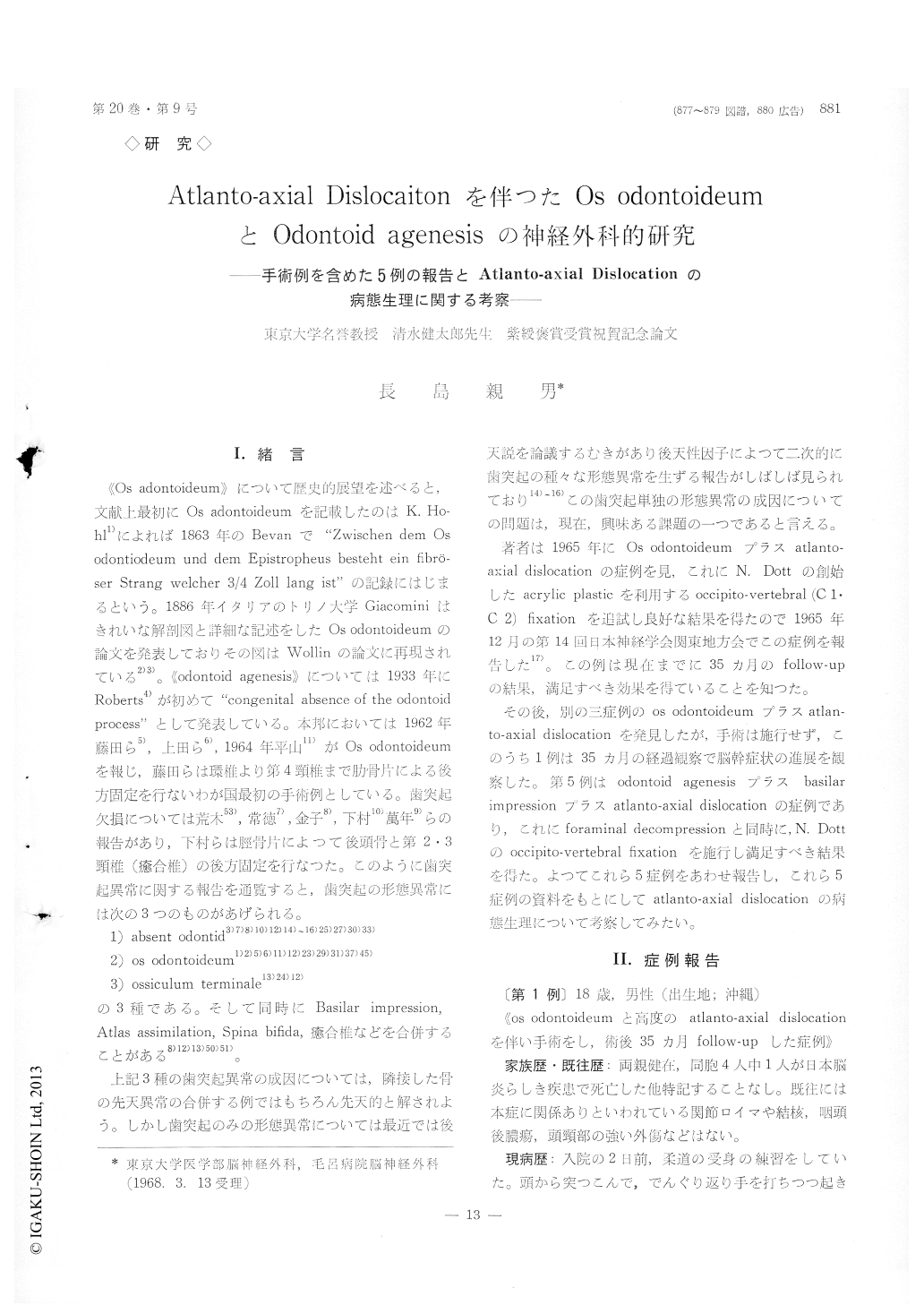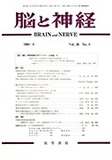Japanese
English
- 有料閲覧
- Abstract 文献概要
- 1ページ目 Look Inside
I.緒言
《Os adontoideurn》について歴史的展望を述べると,文献上最初にOs adontoildeumを記載したのはK.Ho—hl1)によれば1863年のBevanで"Zwischen dem Osodontiodeum und dem Epistroplleus besteht ein fibrö—ser Strang welcher 3/4 Zoll lang ist"の記録にはじまるという。1886年イタリアのトリノ大学Giacominiはきれいな解剖図と詳細な記述をしたOs odontoideumの論文を発表しておりその図はWollinの諭文に再現されている2)3)。《odontoid agenes》については1933年にRoberts4)が初めて"congenital absence of the odontoid process"として発表している。本邦においては1962年藤田ら5),上田ら6),1964年平山11)がOs odontoideumを報じ,藤田らは環惟より第4頸椎まで肋骨片による後方固定を行ないわが国最初の手術例としている。歯突起欠損については荒木53),常徳7),金子8),下村10)萬年9)らの報告があり,下村らは脛骨片によつて後頭骨と第2・3頸惟(癒合椎)の後方固定を行なった。このように歯突起異常に関す報告を通覧すると,歯突起の形態異常には次の3つのものがあげられる。
1) absent odontid3)7)8)10)12)14)〜16)25)27)30)33)
Case presentation was made of five cases having atlanto-axial dislocation. Four had the os odontoid-eum (separate odontoid) and remaining one had the odontoid agenesis with concomittent anomalies of the basilar impression and assimilated atlas. The occipito-vertebral fixation utilizing acrylic plastic which was originally accomplished by Dott in Edinburgh was Performed in two cases of this series. The first op-erated case, 18 year old boy (case 1) who had had frequent severe attacks of fainting, tetraplegia, dys-esthesia and torticollis following trival neck injury showed marked dislocation of atlas on the axis with os odontoideum. With post-operative follow-up of 35 months, this fixation improved neurological de-ficit without recurrence of the attacks. The second operated case 50 year old female (case 5) who had slow but relentless progression of symptoms for 30 Years of period untill complete disability ensued. The urinary incontinence, spastic tetraplegia, sensory loss, marked wasting of muscle of all the limbs, and a coarse vertical type of spontaneous nystagmus were noted. Suboccipital decompression commonly used as treatment of basilar impressin was considered to accelerate the dislocation of atlas on axis. There-fore, a new method consisting of the foraminal de-compression and synchronous occipito-vertebral fixa-tion was performed. With post-operative follow-up of 9 months, this method showed slow but steady improvement of neurologic disability with regain of powers in arms and fingers to use spoon and fork on meal sitting on a wheelchair.
The remaining three treated non-surgically. Two of them (case 3, 23 years male and case 4, 31 years female) revealed to be asymptomatic and the disloca-tion was minimal. The other (case 2, 48 years male) had post-traumatic occurence of frequent attack of vertigo, ataxia and the right hemiparisis and hemihy-poesthesia with X-ray evidence of adanto-axial dis-location of moderate degree associated with os odon-toidum. For the period of 33 months post-trauma, signs and symptoms of brain stem involvement with the cranial nerve paresis of 5th, 7th, 9th, and 10th on the right side had developed interspersed with frequent attacks of vertigo and dizziness. From the fact mentioned above, author discussed the impor-tance of intermittent vertebral artery compression/or obstruction induced by foreward displacement of the atlas in production of some of the brain stem syn-dromes in cases of the adanto-axial dislocation.

Copyright © 1968, Igaku-Shoin Ltd. All rights reserved.


